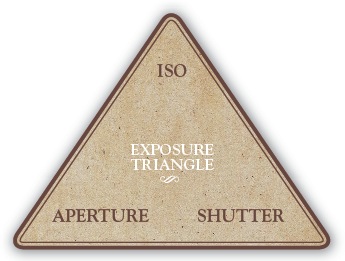EXPOSURE TRIANGLE
There are three key ways light is managed by your camera, and these three elements together are known as the exposure triangle:
The ISO is the sensitivity of the digital sensor (also known as film speed).
The shutter speed controls how long the shutter is open, allowing light to reach the sensor.
The aperture is the size of the lens opening, which allows light to reach the sensor.
Let’s look at this another way: Imagine exposure as a bucket being filled by a hose. The correct exposure is a full bucket. The ISO is the size of the bucket, shutter speed is how long you fill it for, and aperture is the width of the garden hose.

FIGURE 1 The exposure triangle: the ISO, shutter speed, and aperture combine to make an exposure.
In auto mode, your camera chooses all three of the exposure elements, in semi-auto mode your camera chooses one, and in manual mode you make all the choices. Each corner of the triangle works in partnership with the other two—and changing any of these affects how dark or light your image is.
One of the reasons we want to move beyond auto mode is because the camera likes to keep the exposure the same no matter what point of the triangle is changed. For example, if you are in P mode (where the camera chooses the settings, but you can override them) and you change your aperture to let in more light, your shutter speed will increase as well. ...
Get Beyond Auto Mode: A Guide to Taking Control of Your Photography now with the O’Reilly learning platform.
O’Reilly members experience books, live events, courses curated by job role, and more from O’Reilly and nearly 200 top publishers.

